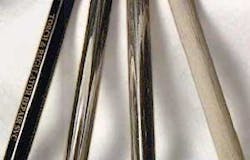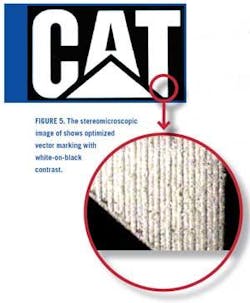The newest generation of plastics material science and laser systems is driving strong industry demand for indelible laser marking as an alternative to conventional ink printing. As a noncontact digital process, direct laser marking of plastics has far-reaching benefits for many industrial applications. Robust plastics laser-marking operations require engineering expertise in areas ranging from the selection of polymeric resins and their chemical formulations through systems integration—a total solutions methodology approach that includes material-science chemistry, primary molding operations, laser technology, and systems integration.
Beam-steered Nd:YAG lasers (arc-lamp and diode-pumped) operating at 1064 nm (near-infrared) are popular in the laser-marking industry due to their emission wavelength, power performance, and versatility. These attributes result in fast marking speeds, high marking quality, and greater production. Based upon the specific application and the plastic-resin material formulation, vanadate and fiber lasers may also yield acceptable results. However, their versatility for marking a broad range of plastics is much more limited than Nd:YAG lasers. As reference, continuous-wave (CW) CO2 lasers operate at a wavelength of 10.6 µm (far-infrared). They generate comparatively much lower peak power and normally cannot produce high-contrast markings on most plastics.
The basic mechanism of beam-steered laser marking, using a wavelength of 1060-1070 nm, is to irradiate the polymer with a high-energy radiation source. The radiant energy is absorbed locally by the material and converted to thermal energy. The thermal energy, in turn, induces reactions in the material substrate. Several types of reactions are possible using the near-IR wavelength region, including charring, ablation, and chemical change. Depending upon the desired marking contrast results, vastly different chemistries and laser system parameters can be selected to achieve the preferred type of reaction.
Material-science chemistry
Depending upon the type of plastic to be marked and its end-use requirements for contrast and sharp/fine-line quality detail, it may not always be necessary to utilize laser-optimized formulations. Instead, proper selection of the wavelength and type of laser can achieve the requisite degree of markability. The results will be determined by factors such as specific grade and properties of the polymeric resin, colorant and filler components, type of laser (wavelength, beam quality output mode, optical configuration, power density, peak/average power, marking speed, and so on), substrate gloss and surface texture, and regrind content. Specific resin grades, such as Styrenics, even within the same generic family can produce dramatically different results.
On the other hand, an often overlooked benefit when considering whether to incorporate laser additives is that optimized laser formulations will improve marking speed, not just the contrast and quality of the decorative or functional marking. The use of laser additives almost always decreases marking cycle times and enables lower laser power to be used. These factors save money and increase manufacturing production.
Achieving an optimal material-science chemistry formulation for plastics laser marking requires expertise in polymers, property grades within polymeric families, colorants, pigments and dyes relative to solubility, particle sizes, threshold concentration limits, color match in use with laser additives, and regulatory certifications (GRAS, FDA Direct/Indirect Food Contact). Material-science solutions must be cost-effective, easy to use, and possess no deleterious effects on the polymer’s physical and chemical properties. For example, mica and other additives (antimony oxides, metal salts such as copper phosphates and sulfates, and black pigments) are available to enhance the laser-marking contrast of resins, but these additives also tend to detract from the long-term mechanical properties and color matches of the base resin.1
A charring reaction occurs when the energy absorbed raises the local temperature of the material surrounding the absorption site to a sufficiently high level that thermal degradation of the polymer is caused. In the presence of oxygen this results in burning of the polymer, but within the workpiece a limited oxygen supply causes a charring of the polymer to form a black mark. The darkness of the mark is dependent on the energy absorbed as well as the material’s thermal degradation pathway (see Fig. 1).
Ablation occurs when the polymer is heated sufficiently to cause degradation and evaporation of the degradation by-products, resulting in an etched area. This marking type normally results in low or no contrast.
Chemical change, through use of additives that release steam during degradation, results in foaming of the polymer. During the foaming process, the laser energy is absorbed by an additive that is in close proximity to the foaming agent. The heat from the absorber causes the foaming agent to degrade, releasing steam. Examples of foaming agents are aluminum hydroxide or various carbonates. To prevent charring, the mechanism requires the polymer to degrade at a temperature higher than that of the foaming additive (see Fig. 2). Through tight control of the laser-operating parameters, high quality and durable light marks can be generated on dark substrates. Poor laser control can result in generation of a friable or low-contrast mark, which can be easily scratched (poor durability).At the completion of the material-science chemistry development phase, the precise laser parameters for optics, beam mode, collimation, power requirements, pulse-repetition rate, and speed will be known, thus enabling exact specifications for the laser equipment.
Primary molding operations
The next phase is to conduct a molding trial using the actual production mold tools and proper letdown ratio of the “laser-optimized” plastic resin and color concentrate, precolor, or liquid color. This step is critical to ensure uniform dispersion and distribution of the optimized color matrix within each molded or extruded part (see Fig. 4).After molding, the product parts are laser-marked to confirm the original formulation results. One technique is to program the laser to continuously mark (scan) the entire product surface. For injection-molded components, the gate design and its location are important factors. Proper setup of injection-molding machine pressures will eliminate dispersion issues. Use of regrind up to approximately 20% normally poses no marking difficulties, however the percent of regrind from batch to batch needs to be consistent.
Laser technology
All beam-steered lasers are not created equal. The hardware and software components a laser manufacturer incorporates into its equipment makes significant differences in marking quality, speed, and versatility. There is not a single universal solution. Each application is unique relative to the plastic-resin-substrate composition and color and the desired marking contrast.
Lasers can be supplied by manufacturers as multimode (MM), transverse electromagnetic mode (TEM00), or anything in-between, including low-order mode (LOM). Beam-quality output mode refers to the energy distribution within the laser beam and is critical to marking performance. These output modes relate to factors including the beam divergence and power distribution across the diameter of the laser beam. A TEM00 laser beam can be focused to the smallest size spot that the focusing optics permit, and the energy distribution in a TEM00 laser beam is most intense at its center and tapers off uniformly from its center to its edges.
TEM00 laser output provides the highest beam quality. Multimode laser output provides the poorest beam quality.
Low-order mode and TEM00 lasers are particularly well suited to high-speed vector marking of single-stroke alphanumerics, filled TrueType fonts, and complex graphics because of their ability to achieve a small focused spot with very-high-power densities, resulting in a very narrow line with well-defined edges that can be drawn quickly. Most plastics applications are optimal using near-TEM00 or TEM00 laser beams.
Power density is a function of focused laser spot size (laser power per unit area, W/cm2). This is different than the raw output power of the laser. Focused laser spot size for any given focal length lens and laser wavelength is a function of laser beam divergence, which is controlled by laser configuration, mode-selecting aperture size, and beam-expander magnification. Pulse-repetition rate (via acousto-optic Q-switch) and peak power density are critical parameters in forming the mark and achieving the optimal contrast and speed.
High peak power at low frequency increases the surface temperature rapidly, vaporizing the material while conducting minimal heat into the substrate. As the pulse repetition increases, a lower peak power produces minimal vaporization but creates more heat. Beam velocity (speed of the laser beam across the work surface) is also a critical factor.
Laser-control software is as important as any hardware component in the marking system. Advanced software algorithms enable unprecedented speed. Beam-steered laser markers are sometimes wrongly conceptualized as (desktop) printers. In fact, they are plotters. Rather than placing individual pixels to create alphanumeric letters or graphics, the laser draws lines, much like writing with pencil and paper. Regardless of the input file format originally used to create the laser-marking objects, all marking is eventually reduced to its most simple form, a list of vector lines to be drawn by the scan head and marked by the laser.
Complex input file formats often used by design engineers may not necessarily yield the best vector laser marking. Figure 5 shows a stereomicroscopic image of white-on-black vector marking (via foaming chemical-change mechanism) of a complex graphic demonstrating well formed lines and sharp edges.Systems integration
The final phase of the total solutions methodology is the integration of laser-marking equipment with materials handling, which may include in-line QC inspection and special lighting. Infinite automation systems, robotics, and machine-vision possibilities exist including “on-the-fly” marking. In any configuration—CDRH Class 1 or Class 4—laser safety must conform to ANSI Z136 standards.
In part, the demand for indelible plastics laser marking is driven by the increasing requirements for component traceability-product unique identification (UID). The US Department of Defense has MIL-STD-130M as the standard practice on military property. Micromarking and machine-vision codes such as 2-D Data Matrix and barcode are frequently marked on plastic components for serialization, traceability, and anticounterfeit.
A recent advancement is cylindrical laser marking in which a round part can be marked up to 180˚ of its circumference without mechanical rotation. This capability (sometimes referred to as distortion correction) is accomplished through the galvanometer scan head and laser operating software. All laser OEMs may not offer this technique on new equipment. Specific laser types can easily be retrofit with this feature capability.
In many applications, there is limited surface area on a part or component to be marked with alphanumerics, logos, schematic diagrams, machine-vision codes, and so forth. Robust Six-Sigma manufacturing operations require all laser-marked products to be 100% human or machine-vision readable, regardless of the size and complexity of details of the actual marking. The forward vision of the total solutions methodology during the early project development assures successful systems integration because the optimized material science, molding operations, and laser technology have been concurrently engineered to meet all of the application requirements.
References
- B. Mulholland and S. Sabreen, “Enlightened Laser Marking,” Lasers & Optronics (July 1997).
- J. B. Carroll Jr. and S. Sabreen, “Laser Marking Additives and Technology,” SPE TOPCON (2007).




